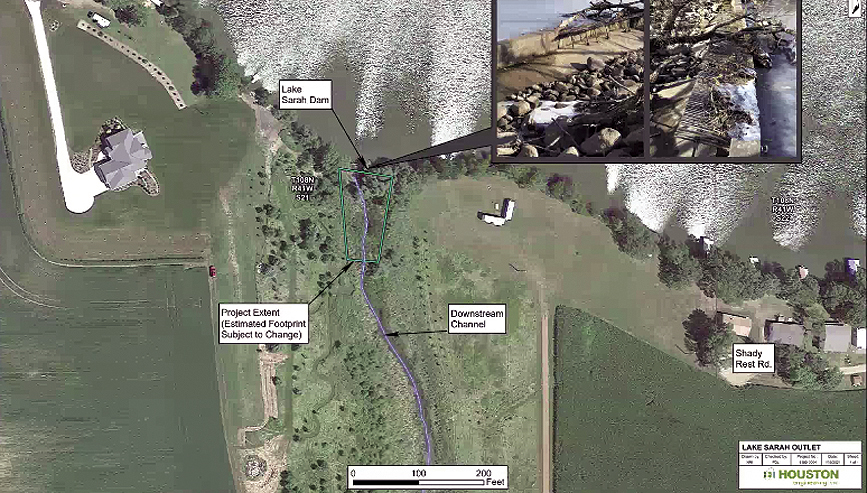
Potential project would replace current structure with rock; lake level would remain unchanged
By Per Peterson
By attempting to emulate natural rapids with various sizes of boulders and rocks, the Minnesota Department of Natural Resources, along with Houston Engineering Inc. hope to further improve the condition of Lake Sarah in northern Murray County.
The Lake Sarah Outlet dam on the south end of the lake was the focus of a Zoom meeting last Wednesday evening and featured representatives from the County, DNR, Area Fisheries and Houston Engineering Inc., a civil engineering and surveying firm based out of Fargo, ND, hired by Murray County to evaluate the design and replacement potential for the dam.
Supporters say the project would replace the current, deteriorating low-head dam with a more economical and ecologically-friendly structure; maintain existing hydraulic performance at the lake outlet, as well as current lake levels; and improve fish habitat and biodiversity.
Low-head dams like the one on Sarah are known to have issues related to species extirpation and extinction, as well as a decrease in biodiversity and species richness.
The so-called Rock Arch Rapids structure that Murray County wants to add on Sarah would provide a viable means to connecting river habitats and provide fish passage for
native species; improve high-quality fish spawning habitats; reduce safety concerns associated with low-head dams; and reduce the need for long-term maintenance.
Rock Arch Rapids, also known as riffle-type dams, are designed to direct flow and energy to the center of the channel away from the banks with step-like drops in water levels, with less than 1 foot drop per arch. Resting pools would foster fish passage for all species in all flow conditions.
Rock Arch Rapids currently exist on various bodies of water in Minnesota, including on the Chippewa River, Otter Tail River and Snake River. In Rock Arch Rapids, a wedge, or ramp, is constructed of base rock with a slope of no greater than 5%. Weirs, or arches, are constructed on the ramp with less than 0.8 foot of head loss per weir.
Eric Jones with HEI said various sizes of rock are used for riffle-type dams, so water is forced to flow through the structure, rather than over it.
“We’ve done it both ways where we’ve left an exiting structure in, and basically built it around the existing structure,” Jones said. “Or, we’ve taken the entire structure out.”
“Any voids in the rocks would be where the smaller rocks will be placed,” said Paul LeClaire from HEI. “In between other voids, even smaller material would be put in; the reason for that is to prevent any sub-surface flows from coming through and reducing lake levels.”
The larger rocks used would be anywhere from 3 to 6 feet in diameter. The contractor would be required to maintain water levels throughout construction.
“They would get a lot of the rock in place before they ever cut down the concrete structure that’s out there,” said Jones.
Tom Kresko, a hydrologist with the Minnesota DNR, said dam modification is not the same as dam removal, and there are no plans to change the water level of the lake.
“The DNR is really looking to partner with the County in trying to come up with a very sustainable and successful project,” Kresko said. “What we’re looking at is trying to find a better structure than what is out there now.”
See this week’s Headlight Herald for more on this article.
